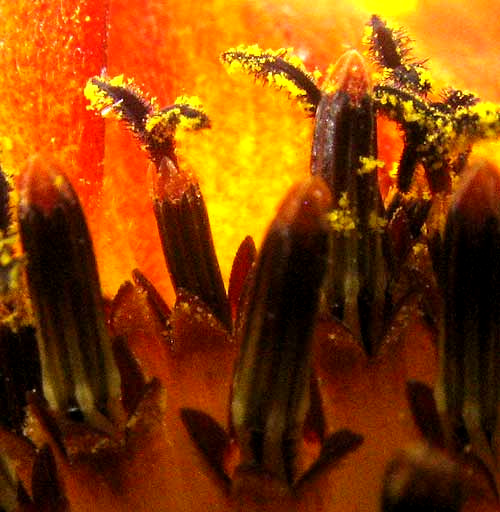Excerpts from Jim Conrad's
Naturalist Newsletter

from the July 28, 2013 Newsletter issued from the Frio Canyon Nature Education Center in the valley of the Dry Frio River in northern Uvalde County, southwestern Texas, on the southern border of the Edwards Plateau; elevation ~1750m (~5750 ft); N29.62°, W99.86°; USA
BACKYARD SUNFLOWERS
This spring my neighbor Phred gave me some sunflower seeds, suggesting that I plant them along the fence next to the red cabin. Now there's a pretty row of blossoming sunflowers along the fence, a pie-pan-size flowering head of which you can see above.
I've grown sunflowers before, but these surprised me. First, they're not the 10-ft-high (3m) giants I'm used to but rather most of them stand between waist and chest high. Also, several cultivar types are represented, including some blossoms that are dark, reddish-brown and others that are bright yellow. You might enjoy reviewing a page displaying various sunflower cultivars (thumbnails at page bottom) at http://rainyside.com/plant_gallery/annuals/Helianthus_annuus.html.
Most cultivated sunflowers derive from the wild HELIANTHUS ANNUUS, though 52 species are assigned to the Sunflower Genus Helianthus, and several of those species are cultivated. All sunflower species are native to North America and Mexico.
In fact, in the book Guns, Germs, and Steel, Jared Diamond asserts that most of the world's important cultivars are Eurasian in origin, with only a relatively few species native to the Americas, and most of those come from South and Central America, and Mexico. The single cultivar of importance worldwide originally from North America is the sunflower.
Though certain sunflower species produce edible tubers -- the Jerusalem artichoke, Helianthus tuberosus, is a sunflower -- it's the "seeds" for which early indigenous Americans domesticated the wild sunflower. The seeds are exceptionally good sources of calories, vitamin E, vitamin B1, magnesium, selenium and other nutrients.
Botanically, of course, sunflower "seeds" aren't seeds. Since sunflowers are members of the huge Composite, Sunflower or Daisy Family, what people call sunflower seeds are actually cypsela-type fruits -- meaning that the fruit is dry, doesn't split open at maturity, and contains just one seed. In our picture the yellow "petals" radiating from the flower-head's "eye" are ray flowers with flat corollas, while the "eye" is composed of hundreds of cylindrical disc flowers. In fact, on fairly mature heads it's easy to knock off the disc flower corollas to see developing "seeds" (cypsela-type fruits) as shown below:

At that picture's top, yellow-orange, cylindrical, disc-flower corollas stand beside one another with dark brown, pollen-daubed style branches from atop the maturing ovary (the future cypsela-type fruit) curling up from inside the corollas' throats. Below the disc-flower corollas the corollas have been removed to reveal maturing, enlarging fruits, or "sunflower seeds." The white, circular items in the center of each fruit are scars left by the disc corollas. On one side of each fruit arises a dark brown, slender, sharp-pointed scale. These are receptacle bracts of the kind we've seen in many Composite Family wildflower heads.
An interesting close-up of the tops of some disc flower corollas is shown below:

There you see fuzzy, curved style branches dusted with yellow pollen and arising from dark cylinders formed by each flower's five anthers fusing together at their margins. The anthers in turn arise from the center of the disk corollas, each corolla topped with five sharp-pointed lobes, which are analogous to a larger flower's five corolla lobes or petals.